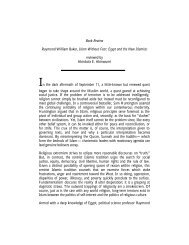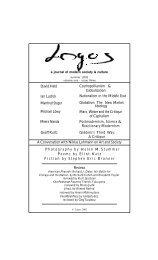Michael J. Thompson Stephen Eric Bronner Wadood Hamad - Logos
Michael J. Thompson Stephen Eric Bronner Wadood Hamad - Logos
Michael J. Thompson Stephen Eric Bronner Wadood Hamad - Logos
You also want an ePaper? Increase the reach of your titles
YUMPU automatically turns print PDFs into web optimized ePapers that Google loves.
Stanley Aronowitz<br />
Durkheim as they did to the critical theory of Karl Marx and Max Weber.<br />
Using many of the tools of conventional social inquiry: surveys, interviews,<br />
data analysis—charts included—Mills takes pains to stay close to the “data”<br />
until the concluding chapters.<br />
But what distinguishes Mills from mainstream sociology, and from Weber,<br />
with whom he shares a considerable portion of his intellectual outlook, is the<br />
standpoint of radical social change, not of fashionable sociological neutrality.<br />
At the height of the Cold War and in the midst of the so-called McCarthy era,<br />
he fearlessly named capitalism as the system of domination from within one of<br />
its intellectual bastions, Columbia University, and distanced himself from exradicals<br />
among his colleagues who were busy “choosing the west,” otherwise<br />
giving aid and comfort to the witch-hunters, or neutering themselves by hiding<br />
behind the ideology of value-free scholarship. Anti-Stalinist to the core, toward<br />
the end of his life he was, nevertheless, accused of pro-Communist sympathies<br />
for his unsparing criticism of the militarization of America and his spirited<br />
defense of the Cuban revolution.<br />
In the light of his later writings which, to say the least, held out little hope for<br />
radical social change in the United States The New Men of Power, Mills’s first<br />
major work, occupies a singular place in the Mills corpus. Written on the heels<br />
of the veritable general strike of industrial workers in 1946, and the<br />
conservative counterattack the following year embedded in the Taft-Hartley<br />
amendments to the Labor Relations Act, the study of America’s labor leaders<br />
argues that for the first time in history the labor movement, having shown its<br />
capacity to shape the political economy, possessed the practical requisites to<br />
become a major actor in American politics as well. But as both “as army<br />
general and a contractor of labor,” a “machine politician” and the head of a<br />
“social movement,” the labor leader occupies contradictory space. (Mills,<br />
1948) By 1948, the year of publication of the first edition of The New Men of<br />
Power, buoyed by American capitalism’s unparalleled global dominance, a<br />
powerful conservative force was arrayed against labor’s recently acquired power<br />
and, according to Mills, had no intention of yielding more ground without an<br />
all-out industrial and political war. Yet, he found union leaders curiously<br />
unprepared for the struggle. Even as their cause was being abandoned by liberal<br />
allies, and belittled and besmirched by their natural enemies among the<br />
corporations and their ideological mouthpieces, right-wing intellectuals and<br />
<strong>Logos</strong> 2.3 – Summer 2003




